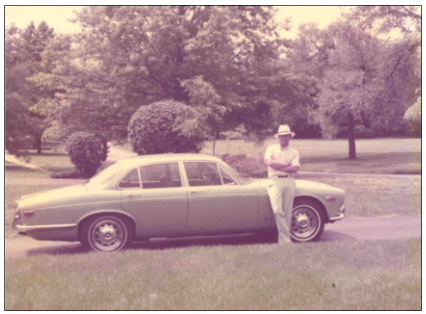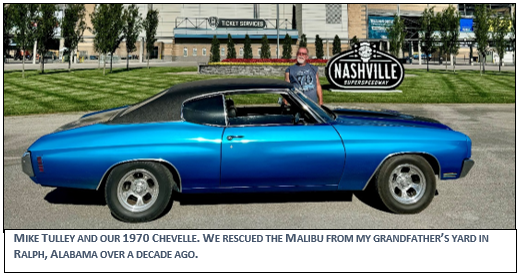Do I Need to Worry?
Bad results aren't always a problem!

Last month we got an email from John, who had some questions about his report. His F250 was showing traces of coolant in the oil, and lead, from bearings, was elevated. He had the engine out of the truck pending repairs and wanted to know: how much lead is too much? Did he need to replace the bearings?
“Do I need to worry?” is a common question, and one there’s not one easy answer for. We’ve had people pull the bearings out of a Corvette when lead was only a few ppm above average and we said in the report, “You don’t need to do anything about this yet.” (For the record, that guy called us and said his bearings looked fine and was kind of honked off about it.) 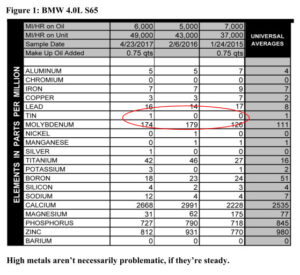
We’ve had people with metals that are high all along, but not changing, and it never turns into a problem. And we’ve had people not pursue what appeared to be a problem, and regret it in the end (this is especially problematic when the engine is in an airplane).
So how do we decide what’s a problem and what’s not? It would be great if there was a magic number, but there’s not. We assess each engine individually, mainly focusing on these things:
- How your sample compares to your trends
- How your sample compares to average
- The balance of metals to each other
- Whether you’re using additives
Trends
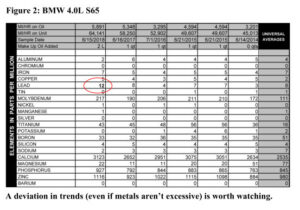 If you have them, trends are the most helpful thing we look at in determining your engine’s health. It takes three samples to get a good trend going (though we can often tell if something is amiss earlier than that).
If you have them, trends are the most helpful thing we look at in determining your engine’s health. It takes three samples to get a good trend going (though we can often tell if something is amiss earlier than that).
All engines are different, as are their drivers, how they’re used, and where they are in the country. As such, it’s very helpful to sample a few oil changes in a row, at least at first, and have a baseline established for your specific engine. Consistency counts. If your engine is wearing a lot but it’s doing so steadily, it’s possible that the metal isn’t a problem. Problems tend to get worse over time – not remain stagnant.
Figure 1 is a good example where lead (a bearing metal) doesn’t appear to be a problem. That engine has more lead than average, but it’s consistent. Since the owner wasn’t having any problems, our recommendation was to just watch lead as time goes on. 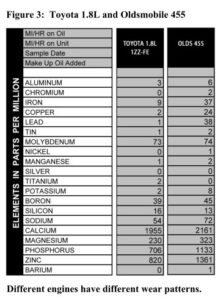
But on the other hand, look at Figure 2. Lead read at just 12 ppm in this sample—that’s well within the average range, but we marked it because lead had always been much lower than this. If this had been his first report, we might have thought lead was okay. But since we know that lead is usually low, we told him the bearings are wearing more than they were and to watch for abnormalities like low oil pressure.
Universal averages
Of course, when you start sampling, you don’t have trends to rely on. So our second line of defense, when we’re looking at your numbers, is universal averages.
We have averages established for most of the engines out there, though we’re always adding to our database as new types of engines (and transmissions and generators and other machinery) are being made all the time. When you do your first sample, we’ll compare your metals to averages for your specific engine.
It’s helpful for us to know what kind of engine you have. Look at Figure 3, for example. This is a comparison between the Toyota 1.8L 1ZZ-FE (used in Corollas and Vibes), and the Oldsmobile 455 (used in older motorhomes and the Cutlass and Trans Am). Toyotas don’t wear much, whereas the Olds 455 makes a lot of metal.
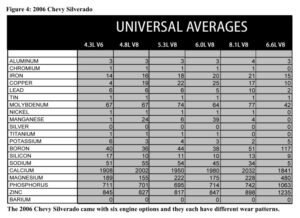 If we don’t know what kind of engine you have, we might end up comparing your numbers to the wrong set of averages, or just a generic engine file. We can still tell if something is way out of line, but the more subtle differences between your engine and averages are harder to see.
If we don’t know what kind of engine you have, we might end up comparing your numbers to the wrong set of averages, or just a generic engine file. We can still tell if something is way out of line, but the more subtle differences between your engine and averages are harder to see.
Along those same lines, some vehicles come with many different engine options, so just telling us the year, make, and model of your vehicle isn’t always enough. The 2006 Silverado, for example, could have one of five different gas engines or the 6.6L diesel engine in it. We have different averages for each of those engine types. Take a look at Figure 4. The metals are similar in those engines, but they’re different enough to matter when we’re determining if something is too high or not.
Generally speaking, we’ll mark a metal in bold when it’s twice average or more. But not always—there are also times when we don’t mark elevated metals, if we know something else is going on.
We test a fleet of armored Sprinter vans that operate in New York City, for example. The vehicles are loaded up with armor and spend their entire lives idling and driving in unforgiving traffic conditions. It’s no surprise that the engines wear more than average. (See Figure 5.)
Balance of metals
We also look at the balance of metals relative to each other. In Figure 6, lead is not reading twice average but we marked it anyway. According to averages, lead and iron should be at about a 1:1 ratio. In this sample, the lead: iron ratio is more like 4:1. This balance tells us the bearings are wearing more than the rest of the engine, and that can be a sign of trouble too. 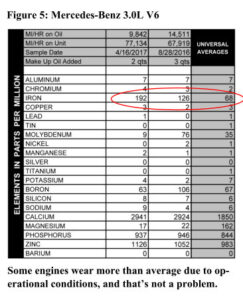
Additives
Another factor to consider is the use of additives and/or leaded fuel. Lots of people use Restore, which has copper and lead in it, and although in that form those elements aren’t harmful, they do make your numbers read high.
Likewise, if you’re using leaded fuel, racing fuel or certain octane boosters, fuel blow-by will cause high lead readings. The highest lead reading we’ve seen in any BMW S65 engine was 1055 ppm. The rest of the metals looked great, though, and the customer had mentioned using an additive, so we were pretty sure the lead in his sample wasn’t a sign of an impending bearing failure.
How much metal is too much?
So how much metal is too much? In truth that number is different for every engine. You already know that we take a lot of things into account in trying to answer that question. Usually we’ll call you to get more information if we’re not sure, and we’ll suggest giving it an oil change or two to see how trends shake out. If something is seriously out of line we can usually tell, even if we don’t know your engine type or how you use it.
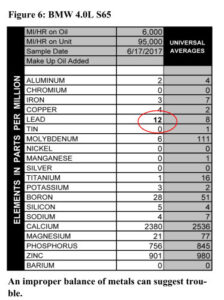
We will say this, though: it’s pretty rare for a major mechanical problem to happen unexpectedly overnight. Most engines will give at least some warning before things go south, and that’s why you do analysis. Follow the trends to see what’s normal for your engine, and when deviations occur, you’re informed enough to make a good decision.
Related articles
A New Wave
Saying goodbye to my 1984 Chevy
TBNs & TANs: Part 2
Determining how heat affects the TBN and TAN of the oil
Finishing the RV-12
The last article in our series on finishing the RV-12
In the Thick of it!
Five cities, five days, 5000+ cars: the 2024 Hot Rod Power Tour!


